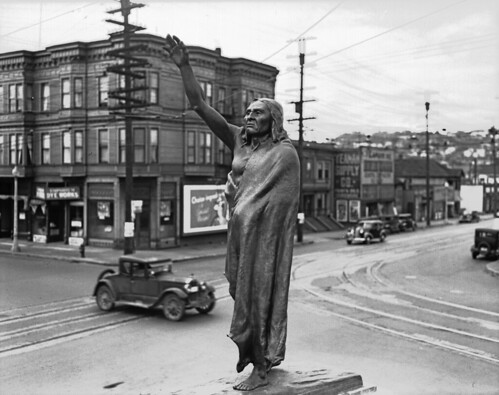
An enduring myth of modern indigeneity is the notion that we are locked into our homelands, venturing out only once in a while to get a feel for the white world. We are the stuff of John Ford films, constantly raising the ire of John Wayne types as they lope across the landscape trying to tame it–and us.
We however have always been beside you. Even in the cities.
Although our modern concept of a city in the American sense is fairly young, the existence of urban Indians–Native Americans residing in and around cities–is not new. Native Americans and Alaska Natives were present at the founding of every major city, and even here in Seattle the presence of Native Americans was always a part of the fabric, and there are still families of the tribes that watched the city come and grow around them here to this day.
The modern Urban Indian, the one we see now, is part of this heritage–but we also exist as a result of weaponized urbanism in the 1950s. In post-war America fears of communism, the machinations of overly thrifty politicians, and certain anti-indian forces embarked on a period of termination. The efforts to end the trust relationship and starve reservations and tribal lands sought to assimilate tribal citizens by using the cities to “civilize” us. Robust programs of relocation, especially under the Indian Relocation Act, were paired with attractive offers of employment and prosperity to draw out tribal citizens from their homelands.
From this, and other forces like the free-will of some yet-nomadic natives, we now see over 3/5ths of all tribal citizens living in the cities–if not more. In many cities the original peoples of the area mingle with citizens of the 566 federally recognized tribes (and the many other tribes still seeking recognition). We fight the same fights.
In spite of this we have thrived in the cities, even when the odds are stacked against us. Those of us in cities have created community, maintained our welcoming open arms to other cultures, and have strived to keep strong the bonds that helped us survive genocide. Some of these bonds are invisible, they rest in our hearts or within our homes where we share them with family and relations. Other bonds, though, are visible in cities around the country in the infrastructure we’ve built like social welfare centers like the Seattle Indian Health Board and community centers like the Daybreak Star Indian Cultural Center, and the long-running cultural events that have welcomed thousands over the years.
Our efforts to survive are done with the knowledge that there’s still a place we call home somewhere in this great expanse of land. For some it’s right under our feet, as with the Duwamish and the City of Seattle. For others, like myself, it’s in places with names like Cache. We also act knowing that all our relations are there with us, striving as always to in some way preserve a way of life that has adapted and grown in the face of generations of genocide and oppression.
Someday we’ll go home, wherever and however that is, and our families that stayed in our traditional lands, or that are with us in our traditional lands, will welcome us and all those rural/urban divides will wash away and we’ll be family just as we’ve always been.
But until then we make the cities our home right alongside you.


